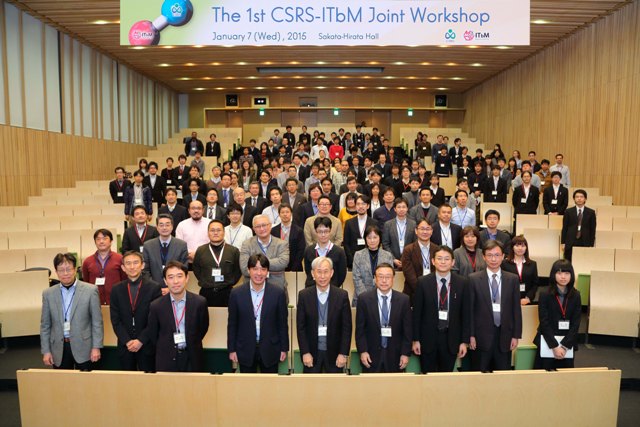Mar 16 2015
The RIKEN Center for Sustainable Resource Science (CSRS) and Nagoya University’s Institute of Transformative Bio-Molecules (WPI-ITbM) have announced that the research centers have entered a collaborative agreement to promote interdisciplinary research, particularly focusing on synthetic chemistry and plant biology. The joint research agreement was signed on January 2015 and is expected to increase the collaboration and accelerate the research between both institutes.
 “The 1st CSRS-ITbM Joint Workshop” (January 2015, Nagoya University)
“The 1st CSRS-ITbM Joint Workshop” (January 2015, Nagoya University)
The Center for Sustainable Resource Science (CSRS) has been founded in April 2013 as one of the strategic research centers of RIKEN. The challenge of CSRS is to achieve a sustainable society that creates, saves and utilizes both resources and energy. This is to be achieved by four unique interdisciplinary projects designed to integrate RIKEN's strong points of plant science, catalytic chemistry and chemical biology.
The Institute of Transformative Bio-Molecules (ITbM) is an international research center established at Nagoya University in October 2012, which has been selected by the Japanese MEXT’s World Premier International Research Center Initiative (WPI). ITbM integrates synthetic chemistry and plant/animal biology, which are strengths of Nagoya University. Through unprecedented “Mix-Lab” approaches and interdisciplinary research, researchers from various fields are working together to generate molecules that can solve urgent food and energy issues that the world currently faces.
To celebrate the joint agreement between CSRS and ITbM, “The 1st CSRS-ITbM Joint Workshop” was held at Nagoya University in January 2015. RIKEN CSRS Center Director Kazuo Shinozaki and Nagoya University ITbM Center Director Kenichiro Itami gave their addresses at the start of the workshop, covering the missions and goals for each center. This was followed by plenary lectures from the Vice-Center Directors, Hiroyuki Osada of CSRS who spoke about his ventures on chemical biology, and Shigehiro Yamaguchi of ITbM who presented his research on the development of fluorescent molecules useful for bio-imaging. “This is the start of an exciting collaboration that is sure to promote the research for both centers,” says Kenichiro Itami, Center Director of ITbM. Oral presentations by 8 other researchers and over 60 poster presentations from both centers were shared amongst 250 people, and were extremely effective in discussing about each other’s research and finding areas for interdisciplinary collaboration.
Through this joint agreement, CSRS and ITbM have agreed to strengthen the collaboration between both centers, along with creating new interdisciplinary research between chemistry and biology. Both CSRS and ITbM aim to establish an international research hub to solve urgent food and energy issues, which will contribute to developing a sustainable society.